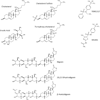Targeting orphan nuclear receptors for treatment of metabolic diseases and autoimmunity
- PMID: 22284354
- PMCID: PMC3269034
- DOI: 10.1016/j.chembiol.2011.12.011
Targeting orphan nuclear receptors for treatment of metabolic diseases and autoimmunity
Abstract
The nuclear receptor (NR) superfamily is composed of 48 members in humans and includes receptors for steroid hormones, thyroid hormone, various lipids and oxysterols. This superfamily has been a rich source of drug targets for myriad diseases including inflammation, cancer, and metabolic disorders. Approximately half of the superfamily have well characterized natural ligands whereas the remaining receptors are considered orphan receptors and remain a focus of a number of investigators assessing their ability to be regulated by ligands. Here, we review recent discoveries that yield important insight into the druggability of three orphan nuclear receptors: the retinoic acid receptor-like orphan receptors (RORs), peroxisome proliferator-activated receptor γ (PPARγ), and liver receptor homolog-1 (LRH-1).
Copyright © 2012 Elsevier Ltd. All rights reserved.
Figures




References
-
- Acton JJ, Black RM, Jones AB, Moller DE, Colwell L, Doebber TW, MacNaul KL, Berger J, Wood HB. Benzoyl 2-methyl indoles as selective PPAR gamma modulators. Bioorganic & Medicinal Chemistry Letters. 2005;15:357–362. - PubMed
-
- Andre E, Gawlas K, Steinmayr M, Becker-Andre M. A novel isoform of the orphan nuclear receptor ROR beta is specifically expressed in pineal gland and retina. Gene. 1998;216:277–283. - PubMed
-
- Beckerandre M, Andre E, Delamarter JF. Identification of nuclear receptor messenger RNAs by RT-PCR amplification of conserved zinc finger motif sequences. Biochem Biophys Res Commun. 1993;194:1371–1379. - PubMed
-
- Berg AH, Combs TP, Du XL, Brownlee M, Scherer PE. The adipocyte-secreted protein Acrp30 enhances hepatic insulin action. Nature Medicine. 2001;7:947–953. - PubMed
Publication types
MeSH terms
Substances
Grants and funding
LinkOut - more resources
Full Text Sources
Other Literature Sources
Medical

